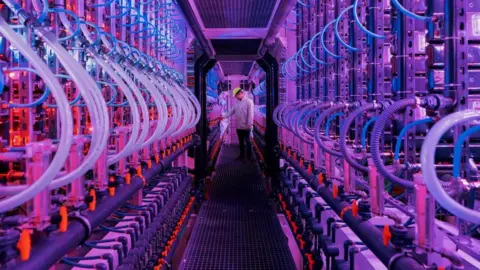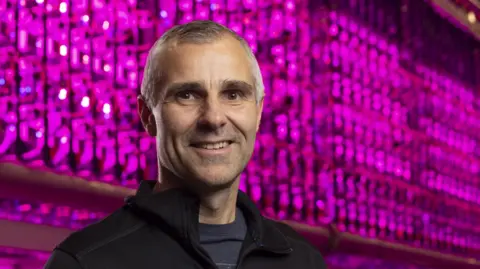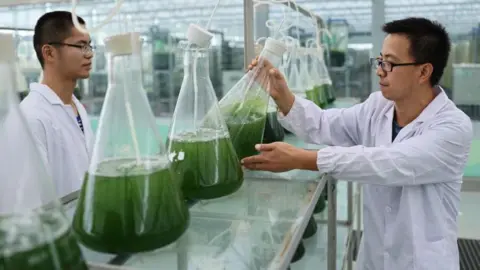 Vaxa
VaxaIn the shadow of Iceland’s largest geothermal power station, a large warehouse houses a hi-tech indoor farm of sorts that’s like nothing I’ve ever seen.
Under a strange pink-purple glow, illuminated panels buzz and cylindrical columns of water bubble away, as a futuristic crop of microalgae grows.
It’s here that Iceland’s Vaxa Technologies has developed a system that harnesses energy and other resources from the nearby power plant, to cultivate these tiny aquatic organisms.
“It’s a new way of thinking about food production,” says general manager, Kristinn Haflidason as he gives me a tour of the space-age facility.
For much of our history, humans have consumed seaweed, also know as macroalgae.
But its tiny relative, microalgae has been a less common food source, although it was eaten for centuries in ancient Central America and Africa.
Now scientists and entrepreneurs are increasingly exploring its potential as a nutrition-rich, sustainable food.
About 35 minutes from the capital Reykjavik, the Vaxa site produces the microalgae Nannochloropsis, both as food for people, and for feed in fish and shrimp farming.
It also grows a type of bacteria called Arthospira, also known as blue-green algae, as it shares similar properties with microalgae.
When dried out it’s know as spirulina and is used as a dietary supplements, a food ingredients, and as a bright-blue food colouring.
These tiny organisms photosynthesise, capturing energy from light to absorb carbon dioxide and release oxygen.
“The algae is eating CO2, or turning the CO2 into biomass,” explains Mr Haflidason. “It’s carbon negative.”
 Vaxa
VaxaVaxa’s plant has a unique situation.
It’s the only place where algae cultivation is integrated with a geothermal power station, which supplies clean electricity, delivers cold water for cultivation, hot water for heating, and even pipes across its CO2 emissions.
“You end up with a slightly negative carbon footprint,” says Asger Munch Smidt-Jensen, a food technology consultant at Danish Technology Institute (DTI), who co-authored a study assessing the environmental impact of Vaxa’s spirulina production.
“We also found a relatively low footprint, both in terms of land and water use.”
Round-the-clock renewable energy, plus a stream of CO2, and nutrients with a low carbon footprint, are needed to ensure the setup is climate-friendly, and he thinks that isn’t easily replicated.
“There is a huge input of energy to run these photo-bioreactors, and you have to artificially simulate the sun, so you need a high energy light source,” he explains.
“My main takeaway is that we should utilise these areas [like Iceland] where we have low impact energy sources to make energy intensive products,” adds Mr Munch Smidt-Jensen.
 Vaxa
VaxaBack at the algae plant, I climb onto an elevated platform, where I’m surrounded by noisy modular units called photo-bioreactors, where thousands upon thousands of tiny red and blue LED lights fuel the microalgae’s growth, in place of sunlight.
They’re also supplied water and nutrients.
“More than 90% of the photosynthesis happens within very specific wavelengths of red and blue light,” explains Mr Haflidason. “We are only giving them the light that they use.”
All the conditions are tightly controlled and optimised by machine learning, he adds.
About 7% of the crop is harvested daily, and rapidly replenished by new growth.
Vaxa’s facility can produce up to 150 metric tonnes of algae annually, and it plans to expand.
As the crops are rich in protein, carbohydrate, omega-3s, fatty-acids, and vitamin B12, Mr Haflidason believes growing microalgae this way, could help tackle global food insecurity.
Many other companies are betting on the potential of microalgae – it’s estimated the market will be worth $25.4bn (£20.5bn) by 2033.
Danish start-up Algiecel has been trialling portable shipping container-sized modules that house photo-bioreactors, and which could link up to carbon-emitting industries to capture their CO2, while simultaneously producing food and feed.
Crops are also being used in cosmetics, pharmaceuticals, biofuel and a replacement for plastic.
Perhaps also microalgae could be produced in space.
In a project funded by the European Space Agency, the Danish Technological Institution plans to test if a microalgae can be grown on the International Space Station.
 Getty Images
Getty ImagesDespite all the investment, there’s some way to go before micro-algae become an everyday part of our diet.
It still needs a lot of development, according to Mr Munch Smidt-Jensen.
He points out that the texture lacks firmness. Meanwhile the taste can be “fishy” if the algae is a saltwater variety.
“But there are ways of coming overcoming this,” he adds.
There’s also the societal question.
“Are people ready for it? How do we make it so that everyone wants to eat this?”
Malene Lihme Olsen, a food scientist at Copenhagen University who researches micro algae, says its nutritional value needs more research.
“Green microalgae [chlorella] have a very robust cell wall, so it can be difficult for us to digest and get all the nutrients,” she says.
For now she says microalgae is better added to other “carrier products” like pasta or bread to help with taste, texture and appearance.
However, Ms Olsen believes microalgae are a promising future food.
“If you compare one hectare of soy in Brazil, and imagine we had one hectare of algae field, you could produce 15 times more protein a year [from the algae].”

Back at the plant I’m looking at an unappetising green sludge. It’s the harvested microalgae with the water squeezed out, ready for further processing.
Mr Haflidason offers me a taste and, after initial reluctance, I try some and find its flavour neutral with a texture like tofu.
“We are absolutely not proposing that anyone should eat green sludge,” jokes Mr Haflidason.
Instead the processed algae is an ingredient for everyday foods, and in Reykjavik one bakery makes bread with Spirulina and a gym puts it in smoothies.
“We’re not going to change what you eat. We’re just going to change the nutritional value of the foods that you eat,” he says.





























+ There are no comments
Add yours